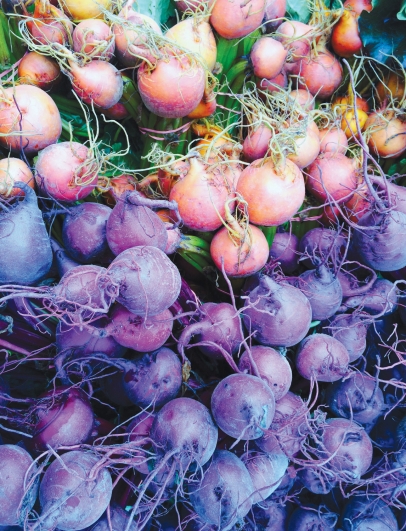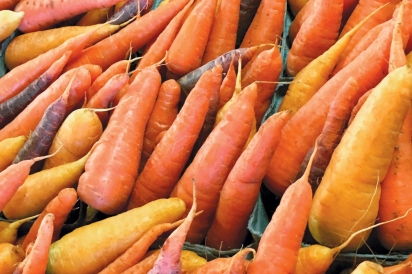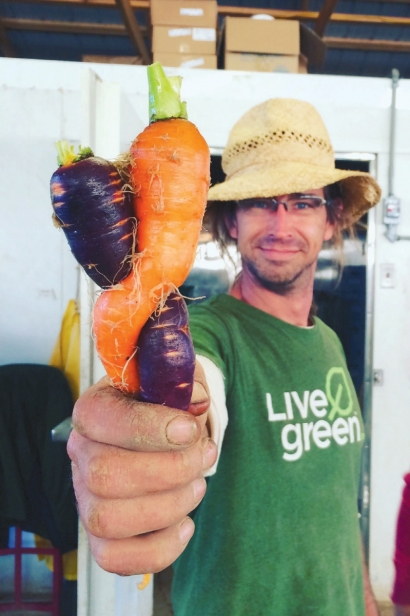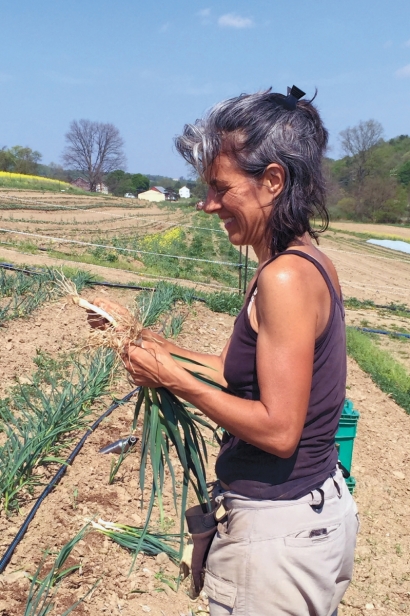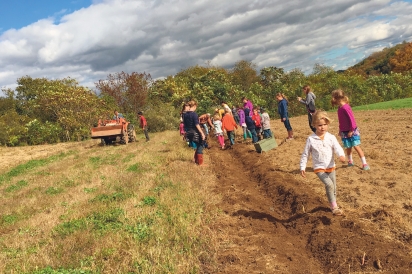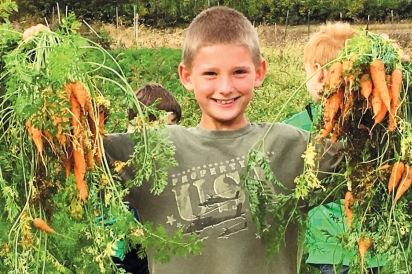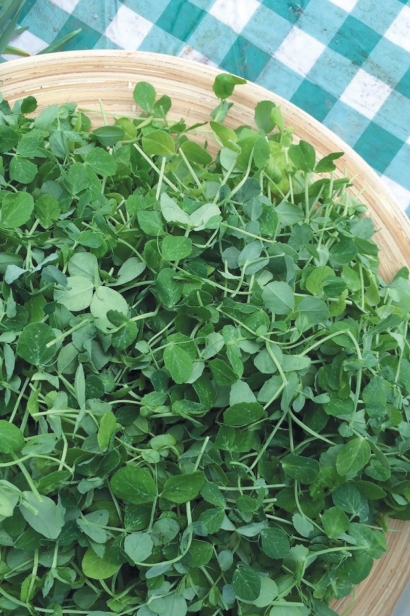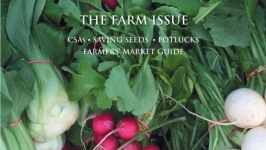CSA Dollars & Cents
Community-supported agriculture started as a way for local food lovers to fund small farms.
But is it working?
At 9:11 a.m. on a cold, sunny day, farmers set up their stands just off the intersection of Germantown Avenue and Mermaid Lane in Chestnut Hill. Every Saturday, the cobblestone road becomes a farmers’ market where, since 2010, Taproot Farm has sold its produce.
Thirty-six-year-old Ola Creston, one of the farm’s co-owners, and her oldest daughter Zeia set up wooden crates of just-pulled carrots and watermelon radishes. They line stacks of plastic boxes containing several types of microgreens, the morning’s hot commodity, second only to the pasture-raised eggs.
By 10:03, four people have made purchases from the Taproot table and Creston has already sold out one of her two coolers of eggs. This is a slow day, Creston explains—hard to imagine, given that the market “opened” at 10. But at the peak of the season, Creston says Taproot brings eight well-stocked tables of produce here, and can hardly keep up with demand for eggs.
On Saturdays, starting in early June, Taproot also holds a drop-off for its community-supported agriculture (CSA) program here. Right now, the CSA and the markets each generate about 40 percent of annual income for Shoemakersville-based Taproot (the rest being wholesale), but Creston says she and her husband, farmer and co-owner George Brittenburg, want to keep expanding the CSA program.
In the CSA model, customers most often pay the farm a total membership fee before the prime growing season begins, then receive weekly or biweekly boxes of freshly harvested produce when the season is at its peak. CSA members, in essence, become investors in the farm. If the growing season is strong, the return will be plentiful; if not, the members need to be prepared for a less robust bounty.
“It’s always a goal of ours to grow the CSA; we just wanted to start small,” Creston says. In 2010, its first year, Taproot’s CSA program had 25 families sign up. But the program expanded relatively quickly. “We went from 25 to 40 to 75 to 125 to 180 [members].” This year, if Taproot’s CSA membership hits 250, Creston and Brittenburg will celebrate.
“Twenty-five members—and we have two adults and two children in our household—is not going to support our family,” Creston adds. A CSA of that size, with shares priced at around $500 for 23 weeks, would generate less than $15,000—hardly enough to make a farm family’s ends meet. “The markets were really what supported us for the first couple years. But we grew the CSA, and the markets helped grow the CSA, and now the CSA is a crucial part of the business.”
That’s a common story for farms that offer a CSA; the program brings in money, but is just one aspect of the overall business. This is common regardless of whether it launched with the farm or came later, has 70 members or 700, or runs year-round or only through summer into fall. Farmers diversify so they can avoid relying on any single income stream, and how much weight they put on their CSAs depends on the family’s needs, the CSA’s location, the land-ownership agreement and a plethora of other factors.
WITH SEEDS PLANTED, AN INDUSTRY BLOOMS
Community-supported agriculture in the United States is young, having gained a foothold only three decades ago. Legend has it that the model stems from a similar program in Japan called teikei, but there’s a general consensus among experts that this story is inaccurate. Writing for the nonprofit Rodale Institute’s website, journalist Steven McFadden describes two American farms that first realized the concept: “While community farm initiatives got under way in both Japan and Chile in the early 1970s, those efforts did not directly influence the 1986 start of the CSA movement in the states. The U.S. impulse came from Europe,” he notes. “The idea crossed the Atlantic and came to life in a new form, CSA, simultaneously but independently … at both Indian Line Farm in Massachusetts and Temple-Wilton Community Farm in New Hampshire.”
Nearly 30 years later, more than 12,000 farms report selling products through such an arrangement. And yet “we don’t know the exact number of CSAs out there, somewhere in the 5,000 to 6,000 range,” says Debra Tropp of the USDA’s Agricultural Marketing Service, which oversees a new voluntary CSA directory [available at ams.usda.gov/local-food-directories/csas]. “We’re trying to build a robust and reliable list. In a few years we’ll have a better chance of knowing the exact size of the sector.”
The results of two small surveys conducted by the USDA offer some picture of this industry. In a survey of 305 CSAs, participants reported 28 percent growth from 2014 to 2015, with members paying more than $36 million total for subscriptions and farmers earning an average CSA income of $35,443. In another survey of 495 CSAs, 58 percent of farmers said their CSAs accounted for half of all of their farm sales. The majority also answered that they expected increased sales in the next two years, partially in response to higher demand for local food.
“For those of us who are more immersed in the scene, you wonder, is the momentum still there, especially for CSAs?” Tropp says. But, she adds, “they feel like they have not realized their full potential.” “It’s a pretty healthy industry,” she adds, noting that her database currently has 693 CSAs, with 35 in Pennsylvania. “We’re talking about something that is largely sustainable [as a model, given its continued growth], and that is encouraging.” But that doesn’t mean running a CSA doesn’t take serious work.
FROM FARM TO BOX TO TABLE
The romanticized version of CSA production goes something like this: The farmers wake up on harvest day and the sun is shining; it’s crisp but not cold enough for a coat. They head out with helpers, and the team spends a couple hours picking, another couple sorting. The produce all looks beautiful—nothing wilted, no unexpected hiccups—and the fi lled boxes head off to their pick-up locations, where smiling customers get a week’s worth of delicious vegetables.
Some of that fairytale can and does happen, like the part where farmers satisfy their CSA customers, but most people likely never consider the extensive and detailed process that takes place before that fare ends up within walking distance of its eaters.
For Creston and the Taproot Farm team, the weekly harvest day runs from 7 a.m. to 7 p.m., sometimes longer, and includes everything from picking produce (starting with the most delicate, to minimize exposure to heat, and ending with the heartiest) to loading it in the pack house, where it gets washed and stored in the walk-in. Once everything’s picked, the team fills the totes with the week’s orders, a mix of three different share sizes ranging from five to twelve items. “Then we have a checklist. I have 18 locations this year,” Creston says. “We have to know exactly how many items are going to which location.”
Having a mix of produce matters, too, with places like Two Gander Farm in Downingtown cultivating more than 100 different varieties of vegetables. “With the Brassica family, our broccolis and cauliflowers, I might be growing 15 varieties just in that family. With lettuce, we’ll probably grow only seven,” says Deirdre Flemming, co-owner with her husband of the seven-year-old farm. “With CSA farming, it is a little bit tricky because you’ve got to keep that variety up.”
That variety is about living up to CSA members’ expectations, which aren’t always realistic, about how many different items should be in their boxes and what that produce should look like. “To have one farmer try to grow 35 or 45 different crops isn’t nearly as efficient as having multiple farmers have something they specialize in,” says Charis Lindrooth, co-owner of Red Earth Farm in Kempton. But the farmers do it anyway, because they love the work and the land and the community built through what Lindrooth describes as the “CSA groupies.”
PRICING PRODUCE, MAKING MONEY
After caring for the land and producing vibrant vegetables, the need to retain members and attract new ones ever year weighs most heavily on CSA farmers.
Two Gander Farm’s CSA right now has 55 members, but Flemming says they’d like to grow that by 50 members a year until they reach 250. That would generate $150,000 a year and make the CSA 50 percent of the farm’s total income. “Right now [we] have only figured out how to pull out 25 percent of our gross to pay ourselves,” Flemming says. “Some farms do a lot better. Dome people are able to get as high as 40 percent.” That means that from the CSA, she and Trey, her husband and farm co-owner, would bring in a combined salary of $35,700. The rest of the money would go toward expenses like infrastructure and soil quality.
Flemming says they considered what it would take to be a CSA-only farm, to give up farmers’ markets and wholesale, and determined they’d have to sell 500 shares in the next two years, assuming they continued only setting aside 25 percent for their income. “It’s a pretty big deal to do a CSA of that size,” she says. “We’re definitely not there yet.”
Such self-awareness—of the farm’s capabilities, of what makes sense for the acreage and staffing, of how a single farm’s CSA decisions affect another’s—comes out in every conversation with these farmers. There’s a sense that no one wants to ruin it for anyone else by offering something undeliverable, turning off future customers from CSAs altogether. That potentially means losing money in the short term due to smaller membership numbers for that year; in the long term, though, the pool of potential customers remains endless.
The CSA model is changing. Community-supported agriculture used to support the farmer by providing consistent and guaranteed income. An aspect of that still exists, but today many farmers try to put buyers before their own bottom line. “We want it to work for the customer, not just for us,” Lindrooth says. “We are grateful for our CSA and we love the community it’s built around us. We get a lot of support that way, and we are making a living doing it.”
Those priorities show in each farm’s pricing model, too. Most CSAs cost a customer anywhere from $20 to $35 a week, and though some farms are more scientific in how they calculate dollar amounts, all take great care in offering a good deal that still brings in cash. “We’re very aware of the price of that bunch of kale or that pint of cherry tomatoes,” says Taproot’s Creston. “We charge for our CSA based on the actual prices going into those shares.”
Red Earth Farm looks at each item, then generates an average. “For example, if a head of lettuce costs $2 and tomatoes cost $5, over the course of the season we total the whole price range and [take] an average,” Lindrooth explains. “A CSA member actually gets a little bit of a discount versus shopping in the market.”
A NEED TO DIVERSIFY
Given that no two farms are truly alike, it’s challenging—and a bit unfair—to generalize. But one notion arises repeatedly, and that’s the need these farms feel to diversify revenue streams in case one stream fails in a given year. A farm whose cash flow comes mostly from one business aspect typically wants to increase what comes in via other avenues. For example, Red Earth’s CSA right now provides somewhere between two-thirds and 75 percent of its income, so the farm is upping wholesale production. Two Gander, on the other hand, wants to reduce its reliance on farmers’ markets by boosting sales from the CSA. “That’s why you’ll see [farmers] do wholesale, CSA, market and maybe even a farm stand—to redistribute the risk,” Flemming says. “With the farmers’ market you’re always dealing with the ups and downs of weather. If we have a really rainy summer, people don’t attend the market. With CSA, the risk is retention.”
Farmers are innovating, too, testing new income opportunities. They’ll add a second CSA season in the winter or extend the number of share weeks. They may add a side pizza business, like one Wisconsin farm did in 2012, or turn leftover produce into a new sellable product, like Penn’s Corner Farm Alliance did. According to Tropp of the USDA, canned-tomato profits for the southwestern Pennsylvania–based Alliance in one year exceeded $10,000.
Red Earth Farm shook up the CSA model somewhat when it introduced an online system allowing CSA members to hand-pick items each week. That flexibility made joining a CSA more inviting to choosy people who never liked the element of surprise in their CSA box. It sets Red Earth apart in an increasingly crowded market, according to Michael Ahlert, Lindrooth’s husband and business partner. “There are certainly a lot more farms doing [CSAs],” he says
A LOOK AHEAD
If Tropp’s surveys and database are any indication, CSAs won’t disappear soon. They’ll continue changing and growing to meet new demands, and Ahlert’s prediction of more competition will likely pan out. Farmers who do this can make a living: maybe not a salary on par with what a different profession could provide, and usually as part of a bigger package of deliverables, but a living nonetheless.
The money, though, is hardly why farmers put themselves through the hardship of producing a CSA. Rather, each of them takes to heart the community part of community-supported agriculture. It’s clear in the way they talk about the people they interact with and in watching them at market, like Creston on that recent Saturday.
The Taproot table there fosters a smattering of mini-reunions. Creston prepares two dozen eggs for a young woman he sees coming 20 strides away, because she knows the order without asking. A man named Andrew returns an empty egg carton; Ernesto, who Creston sees almost every week, stops by for a chat. Dana drops off a book for Zeia. Regulars make their way to the Taproot table because the farm and its vegetables offer more than simple sustenance. They provide extended family, too.
“The CSA has this other lifeline and heart,” Creston says. “It’s an integral part of survival for us.” It may be a project full of challenges, but it’s one that’s full of joy. “My kids will run barefoot on any terrain. I love that,” she says. “It’s a really good life.”
MY CSA LOVE AFFAIR
As I’m speaking with Charis Lindrooth, co-owner of Red Earth Farm, about why CSA farms feel the need to provide such a mix of different vegetables in each week’s box, it hits me: I’m a CSA groupie—of a sort.
“The core of CSA groupies are like you. They love vegetables and they want to experience them and they’re adventuresome,” she says. “Then there’s another crew. They want to eat healthier and they believe that it’s good to support their local farm. They’re super busy and they don’t want to cook too much.”
I fall somewhere in the middle, really. Lindrooth pinpoints my desire to try new produce, to figure out what exactly that alien-looking kohlrabi is or how to use up yet another baseball-bat-sized zucchini. But I also feel a strong pull to support locally produced fare and eat what’s in season.
Author Michael Pollan, writing for The New York Times, describes beautifully how it feels to participate in such a farm membership. “It is less like shopping for food than going out in the garden to see what’s ripe. On Tuesdays and Wednesdays we never plan dinner in advance, preferring to let the farmer— which is to say, a particular patch of soil and the weather—determine the menu for us.”
My first-ever CSA felt like that: On pick-up day, the refrigerator crisper overflowed with leafy greens and ripe tomatoes. My countertop, small as it already was, diminished further with the addition of a handful of butternut squash. So great was the bounty that my family split the share with another, divvying it up after negotiations about who might best use what that week.
I’ve had other not-so-great CSA experiences too, with requirements to pick out the items I wanted from an online marketplace rather than be surprised. Those vegetables satisfied part of why I joined this movement, but it wasn’t the same.
For me, the mystery of what the box will hold, the challenge of coming up with recipes to match its contents, the pleasure of knowing I could drive to the farm that grew the vegetables, the joy of helping to support local agriculture and its people— those are the reasons for my CSA love affair, and it’s one I hope will never end.


